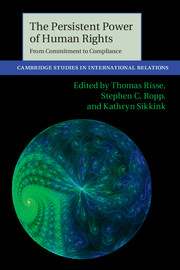Book contents
- Frontmatter
- Contents
- Figures
- Tables
- Contributors
- Preface
- Part I Introduction and stock-taking
- Part II Conceptual and methodological issues
- Part III From ratification to compliance
- Part IV From commitment to compliance
- 11 Encouraging greater compliance
- 12 Business and human rights
- 13 Taming of the warlords
- 14 Changing hearts and minds
- 15 Conclusions
- References
- Index
13 - Taming of the warlords
Commitment and compliance by armed opposition groups in civil wars
Published online by Cambridge University Press: 05 March 2013
- Frontmatter
- Contents
- Figures
- Tables
- Contributors
- Preface
- Part I Introduction and stock-taking
- Part II Conceptual and methodological issues
- Part III From ratification to compliance
- Part IV From commitment to compliance
- 11 Encouraging greater compliance
- 12 Business and human rights
- 13 Taming of the warlords
- 14 Changing hearts and minds
- 15 Conclusions
- References
- Index
Summary
Respect for human rights is difficult to attain even during times of peace. But when conflict occurs, human rights protection and humanitarian assistance becomes an almost insurmountable task. How do we induce compliance from non-state actors such as armed opposition groups? Based on several decades of research on compliance, we seem to know a lot about how states behave, but we know much less about how non-state actors comply with international rules (Simmons 2010). This is an important gap to fill, as non-state actors have become active participants in world politics.
The non-state actors we examine are rebel groups in civil wars. They provide a hard test for commitment and compliance with international rules. The baseline expectation of rebel groups committing to and complying with international standards is low because they are, by definition, political entities fighting against existing authority. The political context they are situated in, namely internal conflict, is a difficult landscape for international law to operate in for two main reasons. First, civil wars tend to be bloody venues where we would least expect compliance to occur, as warring parties tend to privilege their military goals over compliance with human rights and humanitarian rules. Second, norms for non-state actors in civil conflicts are not well established. While the Geneva Conventions provide a common and shared understanding of the laws of war for states, they are less clear when applied to non-state actors. As public international law is the realm of state parties, non-state actors do not have formally established ways to express their intention of being bound by international law. The puzzle for compliance researchers is then how – under what conditions and by what pathways – commitment and compliance arise among armed opposition groups.
- Type
- Chapter
- Information
- The Persistent Power of Human RightsFrom Commitment to Compliance, pp. 239 - 258Publisher: Cambridge University PressPrint publication year: 2013
- 8
- Cited by

